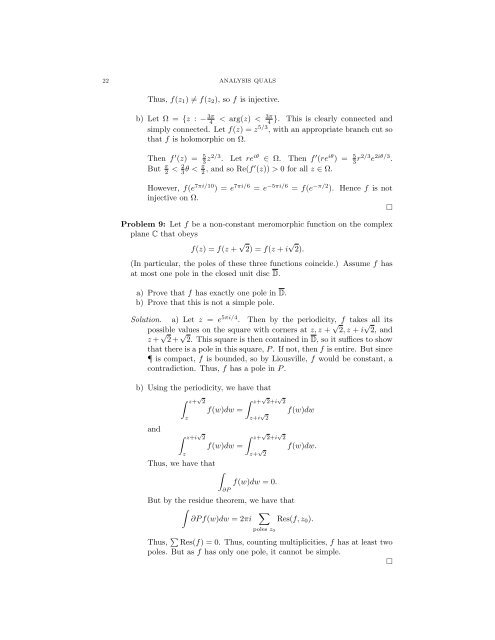ANALYSIS QUALIFYING EXAM PROBLEMS BRIAN LEARY ...
ANALYSIS QUALIFYING EXAM PROBLEMS BRIAN LEARY ...
ANALYSIS QUALIFYING EXAM PROBLEMS BRIAN LEARY ...
You also want an ePaper? Increase the reach of your titles
YUMPU automatically turns print PDFs into web optimized ePapers that Google loves.
22 <strong>ANALYSIS</strong> QUALS<br />
Thus, f(z1) = f(z2), so f is injective.<br />
b) Let Ω = {z : − 3π<br />
4<br />
3π<br />
< arg(z) < 4 }. This is clearly connected and<br />
simply connected. Let f(z) = z 5/3 , with an appropriate branch cut so<br />
that f is holomorphic on Ω.<br />
Then f ′ (z) = 5<br />
3 z2/3 . Let re iθ ∈ Ω. Then f ′ (re iθ ) = 5<br />
3 r2/3 e 2iθ/3 .<br />
But π<br />
2<br />
< 2<br />
3<br />
θ < π<br />
2 , and so Re(f ′ (z)) > 0 for all z ∈ Ω.<br />
However, f(e 7πi/10 ) = e 7πi/6 = e −5πi/6 = f(e −π/2 ). Hence f is not<br />
injective on Ω.<br />
<br />
Problem 9: Let f be a non-constant meromorphic function on the complex<br />
plane C that obeys<br />
f(z) = f(z + √ 2) = f(z + i √ 2).<br />
(In particular, the poles of these three functions coincide.) Assume f has<br />
at most one pole in the closed unit disc D.<br />
a) Prove that f has exactly one pole in D.<br />
b) Prove that this is not a simple pole.<br />
Solution. a) Let z = e 5πi/4 . Then by the periodicity, f takes all its<br />
possible values on the square with corners at z, z + √ 2, z + i √ 2, and<br />
z + √ 2 + √ 2. This square is then contained in D, so it suffices to show<br />
that there is a pole in this square, P . If not, then f is entire. But since<br />
is compact, f is bounded, so by Liousville, f would be constant, a<br />
contradiction. Thus, f has a pole in P .<br />
b) Using the periodicity, we have that<br />
and<br />
z+ √ 2<br />
z<br />
z+i √ 2<br />
z<br />
Thus, we have that <br />
f(w)dw =<br />
f(w)dw =<br />
∂P<br />
z+ √ 2+i √ 2<br />
z+i √ 2<br />
z+ √ 2+i √ 2<br />
z+ √ 2<br />
f(w)dw = 0.<br />
f(w)dw<br />
f(w)dw.<br />
But by the residue theorem, we have that<br />
<br />
∂P f(w)dw = 2πi <br />
Res(f, z0).<br />
poles z0<br />
Thus, Res(f) = 0. Thus, counting multiplicities, f has at least two<br />
poles. But as f has only one pole, it cannot be simple.
















